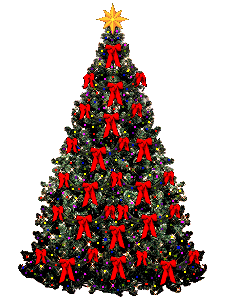|
CHRISTMAS TREE
Some say that the tree represents the tree whose wood was made
into a cross and used to crucify Jesus of Nazareth.
Others say that its origin goes back to the original Tree
of Knowledge and that is why so many early decorations
used apples.
Those who point to the ancient Roman celebration of
Saturnalia as a source for our contemporary trees note
the evergreens were used as decoration during that long ago
holiday that ended on December 25. The evergreen theme
continues to weave its way through the history of Christmas
trees as a symbol of the promise of life to come after
months of cold winter. This particularly holds true in
Germany, the home of many of the legends we still honor in
one way or another.
Over the centuries various saints have been associated with Christmas
trees. An illustration from around 1600 A.D. shows St.
Christopher with the Christ Child riding on his shoulder
and passing under a leafless tree that has a variety of fruit,
candy, baskets and what looks suspiciously like glass ball ornaments
hanging from it. It took more than two centuries, however, and a
transformation from deciduous to evergreen for the idea to more
fully take hold. |

CHRISTMAS CLIPART INDEX
HISTORY
OF CHRISTMAS |
The Celts decorated trees with apples and nuts during the
winter solstice (around December 21), encouraging the sun to
return to bring spring. Other European people had their own
unique tree decorating rituals.
In the 7th century a monk from Crediton, Devonshire, went to
Germany to teach the Word of God. He did many good works there, and
spent much time in Thuringia, an area which was to become the
cradle of the Christmas decoration industry. Legend has it that he
used the triangular shape of the Fir Tree to describe the Holy
Trinity of God the Father, Son and Holy Spirit.
The converted people began to revere the Fir tree as God's Tree,
as they had previously revered the Oak. By the 12th century it was
being hung, upside-down, from ceilings at Christmastime in Central
Europe, as a symbol of Christianity.
The first record of the Christmas tree (as we know it) dates back to
Riga in Latvia, in 1510. In the last quarter of the 16th century,
Martin Luther is said to have decorated a small Christmas Tree
with candles, to show his children how the stars twinkled through
the dark night. Decorated trees became very popular during the
German Yuletide. In 1841, Queen Victoria of England
married Prince Albert of Germany. Albert brought the
Christmas tree custom to England and hence, to the English speaking
world. Many citizens were eager to embrace the traditions of the
English royalty.
In the United States, the Christmas tree was initially not well
accepted by the northern half of America. They frowned upon the
pagan roots of the tree custom. However, Southerners readily
adapted the tradition into their homes, decorating a tree on
Christmas Eve and celebrating for 12 days. Today, the popularity
of the Christmas tree continues around much of the world.
Christmas trees were not limited to a place of honor in the home.
Community trees not only became symbols of holiday spirit and civic
pride, but also served as the only source of a tree for the
estimated eighty percent of Americans at the turn of the Twentieth
Century who did not, or could not, have a tree in their homes.
Today, more than 85 percent of Americans have at least one Christmas
tree in their homes each year, about half of them real and the other
half replicas of trees. And electric utility companies take in an
estimated $30 million in additional revenue.
O Christmas Tree, O Christmas
Tree,
Your branches green delight us.
They're green when summer days are bright:
They're green when winter snow is white.
O Christmas Tree, O Christmas Tree,
Your branches green delight us.
O Tannenbaum (O Christmas Tree) - Christmas
Carol of German origin
